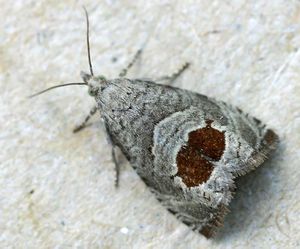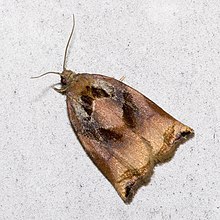Winder
| Winder | ||||||||||
|---|---|---|---|---|---|---|---|---|---|---|

|
||||||||||
| Systematics | ||||||||||
|
||||||||||
| Scientific name | ||||||||||
| Tortricidae | ||||||||||
| Latreille , 1803 |


The curlers (Tortricidae) are a family within the order of the butterflies (Lepidoptera). Around 5,000 species of them are known worldwide to date. In Europe about 1,000 species and subspecies are found, of which 587 species live in Central Europe . Some types of curlers roll up the leaves of their food plants, which is how the family got their name. Their main distribution area are the temperate latitudes and the tropics .
features
The moths are small to medium-sized and usually reach a span of 7 to 35 millimeters. Only a few species reach a wingspan of around 60 millimeters. Many species are dark in color, but there are also some species that are vividly colored. The forewings are rather broad and approximately triangular to square in shape. The hind wings are usually the same width as the fore wings. The forewings have 12 or 13 wing veins with one or two anal veins (1b or 1b and 1c), the hind wings have 9 or 10 veins with three anal veins (1a, 1b and 1c). In the resting position, the body with the wings attached to the abdomen usually has a bell-like shape. Some species have tufts of scales on the forewings and thorax . Your antennae are very short to medium long and never reach more than two thirds of the fore wing length. They are predominantly thread-like, but in some species the males have feathery antennae. In addition to the compound eyes , most species also have point eyes ( Ocelli ). The proboscis is fully developed and scalloped at the base. The maxillary palps are short and vary from undivided and bare to four-limbed and scaled. The labial palps are tripartite and well developed. They are mostly directed forward, sometimes also upward. The female ovipositor is not elongated, as is the case with many other butterfly families, but is formed by wide, flat and hairy lobes.
The caterpillars have four pairs of belly legs and the follower . They have six point eyes on each side of the head.
Way of life
The adults are predominantly crepuscular or nocturnal and sit hidden on tree trunks or under leaves during the day. But there are also diurnal species, such as the Ceracini and Grapholitini species.
The females lay their eggs individually or in groups on the surface of the host plant, in some species this takes place in rows. Sometimes the eggs become covered with either secretions, debris, or abdominal hairs. The eggs are also very different in shape, but most are flattened with the micropyle on top. The eggs are often so flat that they look like scales , but there are also those that are thick and oval in shape. The caterpillars of many species live as miners within the plants or fold or roll up leaves in which they feed. There are also species that eat dead leaves, seeds and roots or live in plant galls or as bores in branches and trunks. There are a few species that are known as pests in agriculture as well as forestry . Well-known examples are the codling moth ( Cydia pomonella ), whose caterpillars develop in fruit, especially apples , or the plum moth . The pupation of the leaf-rolling or folding species usually takes place in a fine web on the food plant, but many boring species pupate on the ground.
Systematics
The winders are structured as follows:
Subfamilies, tribe and genera without tribe allocation:
- Chlidanotinae
-
Olethreutinae
Walsingham , 1895
- Bactrini
- Enarmoniini
- Endotheniini
- Eucosmini Obraztsov , 1946
- Gatesclarkeanini
- Grapholitini
- Lobesiini
- Microcorsini
- Olethreutini
- Dactylioglypha Diakonoff , 1973
- Diakonoffiana Koçak , 1981
-
Tortricinae Latreille , 1802
- Archipini
- Atteriini
- Ceracini
- Cnephasiini
- Cochylini
- Epitymbiini
- Euliini
- Phricanthini
- Ramapesiini
- Schoenotenini
- Sparganothini
- Tortricini Latreille , 1802
- Acmanthina Brown , 2000
- Acroceuthes Meyrick , 1881
- Aeolostoma Meyrick , 1910
- Anisogona Meyrick , 1881
- Anopinella Powell , 1986
- Apateta Turner , 1926
- Apolychrosis Blackbird , 1962
- Assulella Kuznetzov , 1973
- Asthenoptycha Meyrick , 1881
- Barygnathella Diakonoff , 1956
- Bonagota Razowski , 1986
- Brongersmia Diakonoff , 1972
- Campotenes Diakonoff , 1960
- Capnoptycha Meyrick , 1920
- Chapoania Razowski
- Chileulia Powell
- Clarkenia Razowski , 1988
- Cornuticlava Diakonoff , 1960
- Ernocornutia Razowski , 1988
- Haemateulia Razowski , 1999
- Nesochoris Clarke
- Orthocomotis Dognin , 1905
- Paracomotis Razowski
- Paraptila Meyrick
- Punctapinella J.W. Brown , 1991
- Recintonia Razowski
- Seticosta Razowski , 1986
- Silenis Razowski , 1987
- Strophotina Brown
Genera incertae sedis :
- Choristis Turner , 1945
- Heliocosma Meyrick , 1881
Types (selection)
- Adoxophyes orana - fruit peel curlers
- Aethes shakibai
- Agapeta hamana
- Agapeta zoegana
- Ancylis mitterbacheriana
- Archips oporana
- Archips podana - ash moth
- Archips xylosteana
- Celypha lacunana
- Celypha striana
- Choristoneura fumiferana
- Cydia amplana
- Cydia pomonella - codling moth
- Cydia splendana - later chestnut moth
- Cydia strobilella - Spruce cone moth
- Dichrorampha plumbana
- Dichrorampha sequana
- Epagogue grotiana
- Epiblema foenella
- Eucosma conterminana - lettuce seed moth
- Eulia ministrana
- Eupoecilia ambiguella - one-string grape moth
- Grapholita compositella
- Grapholita coronillana
- Grapholita delineana - Small hemp moth
- Grapholita funebrana - plum moth
- Hedya salicella
- Lathronympha strigana
- Lobesia botrana - crossed grape moth
- Notocelia cynosbatella
- Notocelia uddmanniana
- Olethreutes arcuella - olethreutes arcuella
- Pammene fasciana - Formerly chestnut moth
- Pelatea klugiana
- Piniphila bifasciana
- Pseudargyrotoza conwagana
- Psilacantha creserias
- Ptycholoma lecheana
- Rhyacionia buoliana - Pine shoot moth
- Syndemis musculana
- Tortricodes alternella
- Tortrix viridana - oak moth
- Zeiraphera diniana - Gray larch moth
swell
Individual evidence
- ↑ Tortricidae. Fauna Europaea, accessed April 24, 2007 .
- ↑ Tortricidae. Lepiforum e. V., accessed April 24, 2007 .
- ↑ a b c Malcolm J. Scoble: The Lepidoptera: Form, Function and Diversity. Pp. 255ff, Oxford University Press 1995, ISBN 978-0-19-854952-9
- ^ A b N. P. Kristensen: Lepidoptera, Moths and Butterflies, 1: Evolution, Systematics, and Biogeography. Handbuch der Zoologie 4 (35) , p. 199ff, Walter de Gruyter. Berlin, New York 2003, ISBN 3-11-015704-7
- ↑ Tortricidae . www.biolib.cz. Retrieved July 10, 2017.
Web links
- British Insects: the Families of Lepidoptera
- Tortricidae Wickler ( Memento from July 4, 2008 in the Internet Archive )

